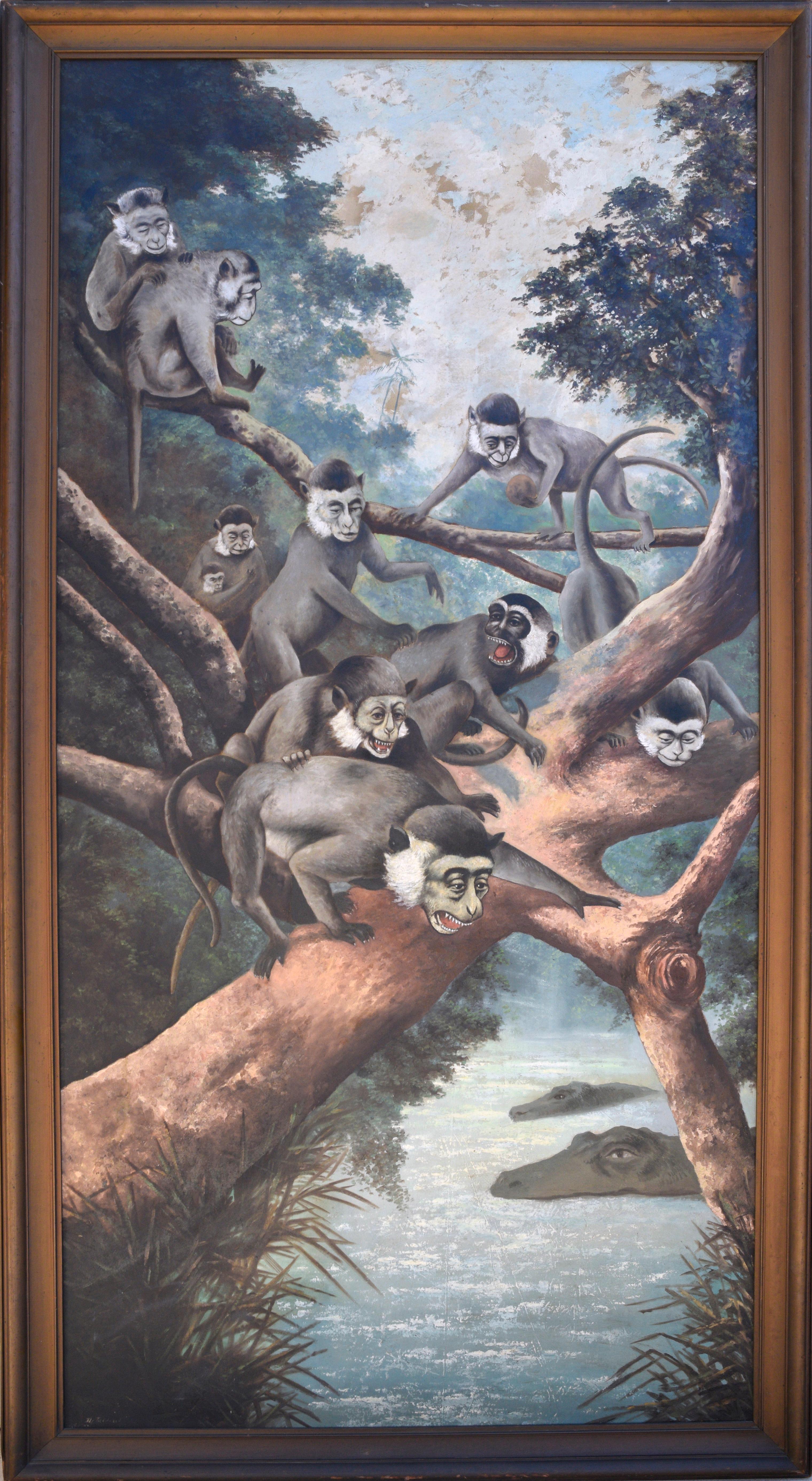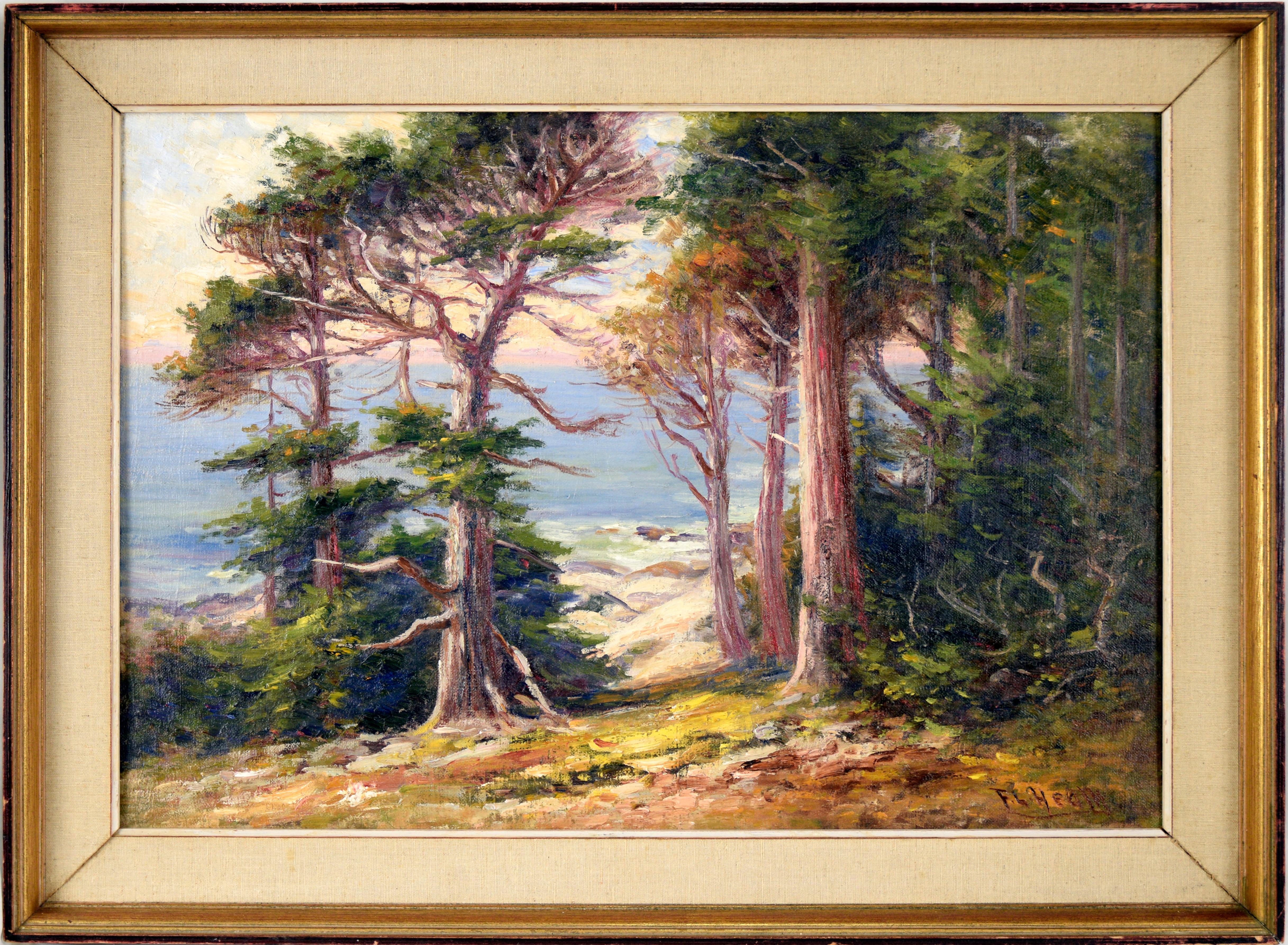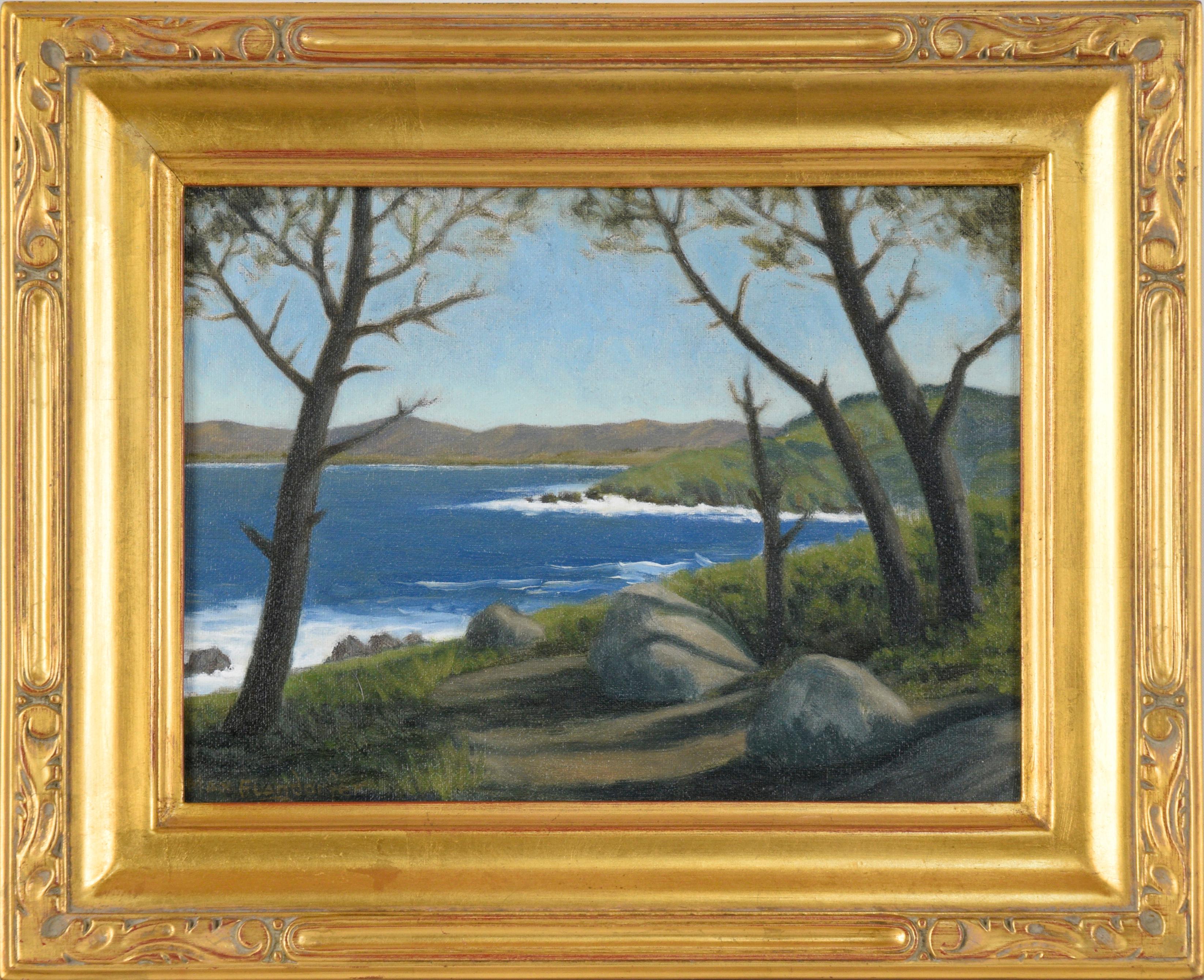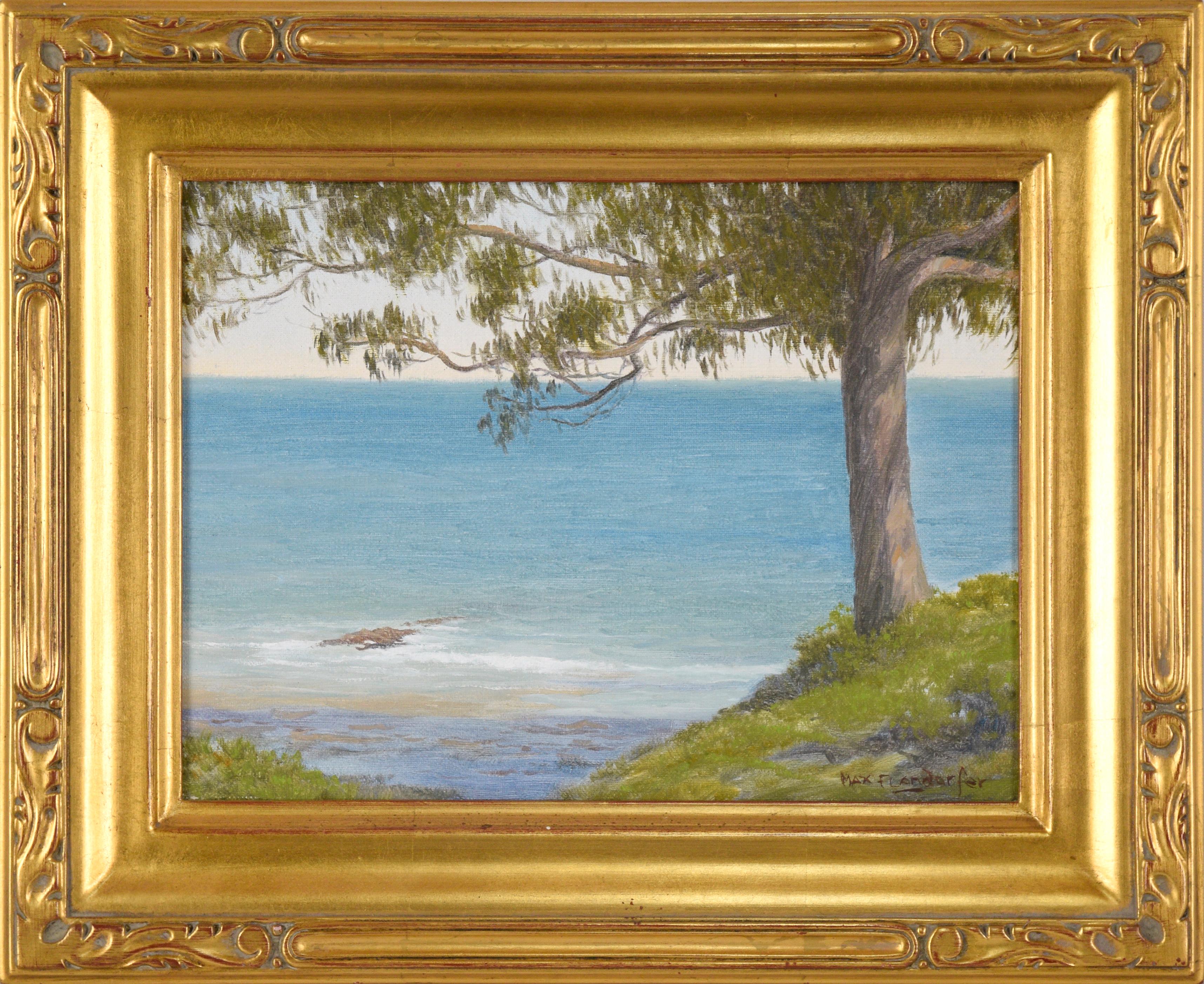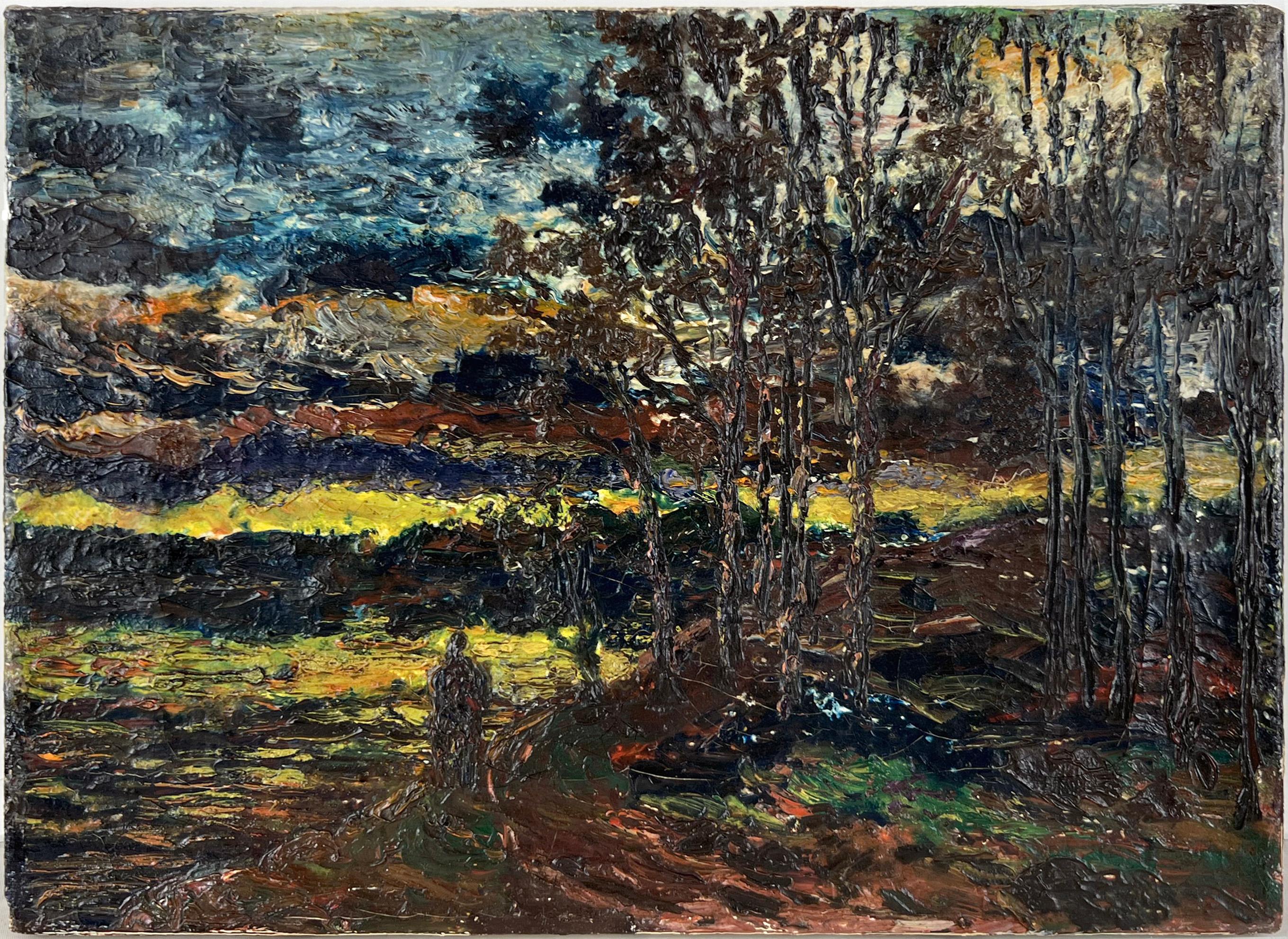Items Similar to Early 20th Century California Landscape - Sunrise On Tin Mountain, Death Valley
Want more images or videos?
Request additional images or videos from the seller
1 of 13
Edward LangleyEarly 20th Century California Landscape - Sunrise On Tin Mountain, Death Valley1913
1913
About the Item
Gorgeous California landscape titled, "Sunrise on Tin Mountain, Death Valley" with Oak in foreground and mountains and Eucalyptus trees in background by Edward Langley (American, 1870 - 1949), 1929. Impasto brushwork adds interest and depth. Signed and dated lower right corner and signed/titled on verso. Condition: Good; professionally cleaned and restored; one tear repaired (see images). Presented in rustic period frame of gilt-toned patinated framed. Image size is 23"H x 28"W.
Edward Langley born in London, England on March 27, 1870. When quite young Langley was abandoned by his parents in Australia. Making his way to Canada, he traveled alone by canoe down to the Gulf of Mexico. In Chicago he worked with Wm Selig in developing the motion picture camera and became a U.S. citizen in 1904. Before that he had played trumpet in the Illinois State Guard for many years. Sometime before 1917 he came to Hollywood, CA with Selig where they produced the pioneer epic, 'The Spoilers." A few years later Langley became art director for the Fairbanks Studio on such films as "Thief of Bagdad," "Three Musketeers," and "Mark of Zorro." From 1921 until 1934 the Langley home in Los Angeles was a gathering place for artists and the film colony. Close Friends with Mary Pickford and Douglas Fairbanks. When not busy with the movies, he was active in the local art scene. As a lecturer at local women's clubs, he used his paintings and special lighting effects to show the moods of the desert. Langley was painting in Japan when war erupted and was a prisoner there until 1943. Returning to California, he lived in Salinas, Laguna, and La Jolla where he taught painting classes. He died in Los Angeles on May 11, 1949, Langley is best known for his southern California desertscapes. Exhibition: Painters & Sculptors of LA, 1926; Mission Inn (Riverside), 1927; Bullocks (LA), 1929 (solo); Ebell Club (LA), 1920s. In: Desert Hot Springs (CA) Museum; Nevada Museum (Reno). PF; lnvw; CA&A; CD; SCA; DR.
From an article in Riverside Daily Press, Jan. 2, 1928, p. 6.
Edward Langley was a painter of desert scenes, who was active with Atascadero Studios, 1917 and other studios in Hollywood in the 1920s and 1930s. “Choosing as his topic, ‘The Evolution of the Motion Picture,’ Edward Langley, technical director of the Fairbanks-Pickford studio, will lecture at 7:30 o’clock tonight in the Little Theatre. ‘The first enemy of the motion picture,’ said Langley recently in an interview, ‘was the saloon. The innovation of the motion picture, as an amusement, gave many a new diversion and drew them away from the saloons.’ Langley, who has been with the Fairbanks production company for more than seven years, confesses that his hobby is neither golf nor tennis, but sketching and painting. Painting the California desert and studying its moods is his chief delight. … Langley may be considered as an important figure in the world of art. He sings and plays the cello, is writing a book on motion picture work, and lectures frequently aside from his work as technical director. At present the artist has 250 sketches, drawings, engravings, and water colorings on exhibition at the Chamber of Commerce in Los Angeles. He is a member of the Painters and Sculptors Club of California and a member of the Board of Governors of Artland, an artists’ club of Los Angeles. Research Attractive. ‘One of the beauties of a technical director’s work is the vast amount of research necessary to gather information as a background for the production of any picture. Before we began filming ‘The Three Musketeers’ I read thirteen histories of France in order to understand the character of the people, their mannerisms, how they ate and drank, the size of the buildings during that era, and other similar things about the period. ‘I think I have read all the pirate stories ever written,’ declared Langley in speaking of the preliminary work on ‘The Black Pirate,’ which is now playing in San Francisco and is the first complete picture produced in Technicolor photography. Langley, who is a pioneer in the motion picture industry, started in the field of photography before the introduction of the motion picture which was first begun in 1901. For about six years previous to that time, the director was concerned with the production of slides and pictures. Slides Once Used. In outlining the history of the slides, Langley remarked: ‘When we wanted to put on in a small town, an entertainment with slides, we secured a store, whitewashed its back wall, arranged some chairs in the room, and hung out a big sign in front of the store. There was no attempt made to have the slides tell a continuous story except as one slide would represent a man being chased up a tree by a dog with the succeeding slide showing him falling out of the tree. ‘The large sum of five cents was charged each person who came to the entertainment. The whole show lasted only about thirty minutes.’ Begins with ‘The Spoilers’. Fifteen or sixteen years ago, Edward Langley came to the Pacific Coast as technical director of ‘The Spoilers,’ the first big picture ever produced on the Pacific Coast. He was a member of the art staff producing the Jack London series and was concerned with several other ventures in the motion picture industry before becoming an art director for Douglas Fairbanks. ‘We call them Doug and Mary,’ said Langley, when asked about Mr. and Mrs. Fairbanks. ‘Mary is one of the sweetest girls I have ever known. She is full of joy and happiness and Doug is full of pep, always playing a prank on us or showing us a new trick. ‘I believe the success of the Fairbanks studio results from the co-operation of the film stars and their staff of workers.’ All the high schools in San Francisco are to hear Edward Langley lecture on the motion picture. This morning he spoke before the San Francisco Polytechnic school and will address the other student bodies during the next two weeks,” per The Daily Palo Alto, Stanford University, April 13, 1926, pp. 1, 4 (on the Internet). “Langley Paintings Displayed at Inn… Mission Inn… One of the most delightful features of his work is his ability to interpret music in oil. Included in the exhibit… are several musical moods, or tone-poems as he calls them. One, suggested by Mendelssohn’s Spring Song, is a lovely dream in green, its trees and lake and flowers veiled by the mist of imagination. His interpretation of a Schumann prelude suggests the cathedral through its handling of a forest glade. Light and airy as the French court of Louis XIII waltz. A picture of Cadman’s ‘Canoe Song’ is interesting. In direct contrast to these pictures, which might almost be termed spiritual, so ethereal are they, are the pictures of the desert. Mr. Langley excels in his portrayal of the brassy heat of the desert.… Sunset moods.… Scenes in and around Death Valley, where Mr. Langley spent some weeks with his friend, ‘Death Valley’ Scotty, recently, show a Dore quality… handling of the chasms and valleys of the region… Mr. Langley is a versatile man. He paints. He writes. He plays the cello. He has sung in opera. He is now art director for Douglas Fairbanks, and has worked in the art field of motion pictures for 29 years. His wife is a pianist of distinction, and their small daughter is a dancer…,” Riverside Daily Press, Jan. 2, 1928, p. 6.
Prior to shipping, our resident Art Conservator will inspect the piece and if necessary clean, remove any old, yellowed varnish, repair blemishes and minor issues and put on coat of UV-resistant varnish to insure against future tonal depreciation.
- Creator:Edward Langley (American)
- Creation Year:1913
- Dimensions:Height: 26.5 in (67.31 cm)Width: 32 in (81.28 cm)Depth: 2 in (5.08 cm)
- Medium:
- Movement & Style:
- Period:
- Condition:Very good. Professionally cleaned and restored; one tear repaired (see images). Frames are included “as is,” but as a courtesy, minor cosmetic issues will be retouched as necessary prior to shipping.
- Gallery Location:Soquel, CA
- Reference Number:
About the Seller
4.9
Platinum Seller
These expertly vetted sellers are 1stDibs' most experienced sellers and are rated highest by our customers.
Established in 1986
1stDibs seller since 2014
2,545 sales on 1stDibs
Typical response time: <1 hour
- ShippingRetrieving quote...Ships From: Soquel, CA
- Return PolicyA return for this item may be initiated within 14 days of delivery.
More From This SellerView All
- "Noah's Ark", Monkeys in Trees w. Crocodiles, Richard DeTreville 1924 San MateoBy Richard DeTrevilleLocated in Soquel, CA"Noah's Ark", Monkeys in Trees w. Crocodiles, Richard DeTreville 1924 San Mateo A lively, large-scale vertical painting of Macaques monkeys in the trees abo...Category
1920s American Impressionist Landscape Paintings
MaterialsOil, Linen
- Old 17 Mile Drive, Carmel California Landscape Early 1900s Oil on LinenLocated in Soquel, CAOld 17 Mile Drive, Carmel California Landscape Early 1900s Oil on Linen Gorgeous early 20th century landscape of rugged Carmel Old 17 Mile Drive coastline by Frank Lucien Heath...Category
Early 1900s American Impressionist Landscape Paintings
MaterialsLinen, Oil
- "Sunset Pt. Lobos, CA" Coastal Landscape in Oil on LinenBy Max FlandorferLocated in Soquel, CA"Sunset Pt. Lobos, CA" Coastal Landscape in Oil on Linen Oil painting of a coastal landscape by Max Flandorfer (American, b. 1962). Large trees along a path are at the edge of a cliff overlooking the water. The cliff is covered in green grass. Below, there is a dark blue ocean...Category
Early 2000s American Impressionist Landscape Paintings
MaterialsLinen, Oil
- "West Cliff, Santa Cruz" Coastal Landscape in Oil on LinenBy Max FlandorferLocated in Soquel, CA"West Cliff, Santa Cruz" Coastal Landscape in Oil on Linen Oil painting of the a beach landscape by Max Flandorfer (American, b. 1962). A large eucalyptus tree is at the edge of a c...Category
Early 2000s American Impressionist Landscape Paintings
MaterialsLinen, Oil
- Sunrise on Nantucket Island Fisherman Gazing at the Sky 1929Located in Soquel, CASunrise on Nantucket Island Fisherman Gazing at the Sky 1929 Nantucket Sunrise, a Fisherman is gazing at the sky by James Francis Barker (American, 1872 – 1950). In the style of Albert Pinkham Ryder (1847 - 1917) was active/lived in New York, Massachusetts. Albert Ryder is known for Romanticism-pastoral landscape painting. Barker has a heavy impasto and extensive brushwork throughout and captures American Post Impressionism with this early sunrise on Nantucket Island scene. Image, 10.25"H x 14.25"W Signed "J. F. Barker" dated "3/29" on Stretcher bar verso Signed James F. Barker on Linen verso James F. Barker’s lineage traces back to eleven of the original Nantucket settlers. He was born in 1872 in Keokuk, Iowa, the son of a railroad ticketing agent and a New Orleanian of Spanish and French extraction. His ancestors on his father's side included 11 of the 15 families who settled Nantucket in 1659. He graduated from Cornell University in 1893 with a degree in Mechanical Engineering and spent another year studying Architecture at the graduate level. He briefly worked at D. H. Burnham & Company and Allis-Chalmers Manufacturing Co. before switching to education, With a degree in mechanical engineering and graduate degree in architecture, his career was centered among institutes of higher learning. Barker was also a skilled painter and a talented photographer. Barker specialized in waterfront, wharf, and beach scenes. The artist exhibited his work during the summer months at the Eagle’s Wing Studio on Union Street, having named the studio after a steamer, which had been captained by his grandfather. James Francis Barker (1872 – 10 December 1950) was the second president of the Rochester Athenæum and Mechanics Institute, succeeding Carleton B. Gibson, from 1916–1919. He also pursued painting, pottery, metal working, and cabinet making. Gravestone in Prospect Hill Cemetery, Nantucket He was born in 1872 in Keokuk, Iowa, the son of a railroad ticketing agent and a New Orleanian of Spanish and French extraction. His ancestors on his father's side included 11 of the 15 families who settled Nantucket in 1659. He graduated from Cornell University in 1893 with a degree in Mechanical Engineering and spent another year studying Architecture at the graduate level. He briefly worked at D. H. Burnham & Company and Allis-Chalmers Manufacturing Co. before switching to education, becoming Superintendent of the Manual Training Department at East Division High School in Milwaukee, Wisconsin in 1897. He left in 1904 to pursue similar positions at Grand Rapids High School and the Hackley School in Muskegon, Michigan. In 1906, he participated in the formation of East Technical High School in Cleveland, Ohio and served as its first principal. He married the former Kate Spooner in 1897 and raised one daughter. After being widowed in the late 1930s, he married Josephine M...Category
1920s American Impressionist Figurative Paintings
MaterialsOil, Linen
- High Sierras Log Cabin Lodge with Poppies Original Painting by J. Bond FranciscoLocated in Soquel, CAHigh Sierras Log Cabin Lodge Original Oil Painting by J. Bond Francisco Early 1900s era impasto painting of the High Sierras and a Log Cabin Lodge by California artist John Bond Francisco (American, 1863 - 1931). Well painted landscape of early 20th century California High Sierras will lush green grass and California Poppies. Signed lower right "J. bond Francisco." Presented in a newer, custom, giltwood frame. Image, 12"H x 16"W Frame 23.5"H 19.5"W x 1.25"D John Bond Francisco was born in Cincinnati, OH on Dec. 14, 1863. From an early age Francisco was drawn to both music and art. He studied the violin with Hermann Eckhardt and painting at the Cincinnati Art Academy for several years. He arrived in Los Angeles in 1887 and was so taken with the beauty of the place, he opted to make it his home. He soon continued his studies in Berlin, Munich, and in Paris at Académies Julian and Colarossi under Courtois, Bouguereau, and Robert-Fleury. While in Europe he studied the violin in the morning hours and painting in the afternoon. Upon returning to Los Angeles in 1892, he married and built a home at 1401 Albany Street where he lived for the rest of his life. Combining an art and music career, he helped form the Los Angeles Symphony Orchestra in 1897 and served as their first concert master. While teaching music and art at his studio, he made painting excursions into the surrounding countryside, often with his pupil Elmer Wachtel. He combined his Munich technique with that of the Barbizon's influence to produce paintings of California deserts and mountains that held dramatic light and shade contrasts. Later his palette brightened and he leaned more toward Impressionism. Francisco's studio in the Blanchard Bldg and his home were a mecca for both painters and musicians until his death on Jan. 8, 1931. Member: American Artists Club (Munich); Calif. Art Club; Laguna Beach AA; Painters & Sculptors of LA; Athletic Club (LA); LA AA. Exh: Calif. Bldg, World's Columbian Expo (Chicago), 1893; Chamber of Commerce (LA), 1894; Ruskin Art Club (LA), 1902-04; Blanchard Hall (LA), 1907; Alaska Yukon Expo (Seattle), 1909 (gold medal); Hallett Gallery (LA), 1910; Daniell Gallery (LA), 1912; LACMA, 1914; Friday Morning Club (LA), 1915; Biltmore Salon (LA), 1925. In: UCLA; LACMA; Orange County (CA) Museum. Edan Hughes, "Artists in California, 1786-1940" Out West, Sept. 1913; Graphic, 3-10-1918; Who's Who in the Pacific Southwest...Category
1910s American Impressionist Landscape Paintings
MaterialsMasonite, Oil, Linen
You May Also Like
- Dmitri Wright - Compline Ora Pro Nobis, Painting 2015By Dmitri WrightLocated in Greenwich, CT"Compline is a recent piece, a work honoring New England. It is a culmination of what I developed and experienced from those decades painting and trekking through the northeast in th...Category
2010s American Impressionist Abstract Paintings
MaterialsLinen, Paint, Oil
- Oil on Linen Painting -- Green River RocksBy Conard HoltonLocated in Troy, NYThis wonderful scene depicts a bright blue river flowing through a rich forested area. Achieved through plein air, the vibrant blues, teals and whites of the water allow it to stand ...Category
2010s American Impressionist Landscape Paintings
MaterialsCanvas, Linen, Oil
- Dmitri Wright - Giocoso Opus 2, Painting 2018By Dmitri WrightLocated in Greenwich, CTPROVENCAL Series: “In [this] series I was exploring the classical influences of the impressionist masters, to build on their ideas to move them forward, yet being true to the many ap...Category
2010s American Impressionist Abstract Paintings
MaterialsLinen, Paint, Oil
- Autumn Cottonwood in the Arroyo , Oil PaintingBy David GrossmannLocated in Denver, CODavid Grossman's (US based) "Autumn Cottonwood in the Arroyo " is an oil painting that depicts a Cottonwood Tree's changing autumn leaves with a vast mountain background. David Gro...Category
2010s American Impressionist Landscape Paintings
MaterialsOil, Linen
- "Roadside New Mexico" - Landscape, New Mexico by renowned painterLocated in Rockport, MARobert, an accomplished illustrator and fine artist with educational background from Pratt Institute and ArtCenter, has devoted many years to his craft. Currently, he's not only an i...Category
21st Century and Contemporary American Impressionist Landscape Paintings
MaterialsLinen, Oil, Panel
- October Cottonwood with Coming Storm , Oil PaintingBy David GrossmannLocated in Denver, CODavid Grossman's (US based) "October Cottonwood with Coming Storm " is an oil painting that depicts a cottonwood tree's brilliant changing autumn leaves with a storm brewing in the d...Category
2010s American Impressionist Landscape Paintings
MaterialsOil, Linen
Recently Viewed
View AllMore Ways To Browse
Antique Death
Old California Art
Yellow Art Late 20th Century
American Drew Chairs
Edward Mayer
Mountain Women
Motion Picture
Japanese Landscape Antique
Antique American High Chairs
American Chair Company Antique
Dance Of Death
Oil On Tin
Japanese Mountain Landscape
Antique Tin Art
Antique Tin Paint
Small Tin
Nevada California
Antique Camera Art
